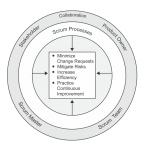Self-Organizing can be defined as team of motivated Individuals working towards the achievement of a specific goal, self-motivated and have the ability and authority to make decisions and are open to changing demands.
Scrum defines employees as self-motivated group or team who seek to accept greater responsibility. So, they deliver much greater value when self-organized. They pull work for themselves rather than waiting for some on to assign work for them, thus creating a greater sense of commitment and ownership. They tend to manage their whole work as a group and enhance their skills continuously.
Benefits of Self-organization
In order to create a successful self-organizing team, it should consist of five essential components. They are: Competency, Collaboration, Motivation, Trust and Respect and finally Continuity.
Self-organization does not mean that team members are allowed to act in any manner that they want to. It just means that once the Product Vision is defined in the Create Project Vision process, the Product Owner, Scrum Master, and Scrum Team get identified. Also the Scrum Core Team itself works very closely with relevant Stakeholder(s) for refining requirements better as they go through the Develop Epic(s) and Create User Stories process. Team expertise is used to assess the inputs needed to execute the planned work of the project. This judgment and expertise are applied to all technical and management aspects of the project during the Create Deliverables process.
Although prioritization is primarily done by the Product Owner who represents the Voice of Customer, the self-organized Scrum Team is involved in task breakdown and estimation during the Create Tasks and Estimate Tasks processes. During these processes, each team member is responsible for determining what work he or she will be doing. During the execution of a Sprint, if team members need any help with completing their tasks, Scrum addresses this through the regular interaction mandatory with the Daily Stand up Meetings. The Scrum Team itself interacts with other teams through the Scrum of Scrums Meetings and can look for additional guidance as required from the Scrum Guidance Body.
Finally, the Scrum Team and Scrum Master work closely to demonstrate the product increment created during the Sprint in the Demonstrate and Validate Sprint process where properly completed deliverables are accepted. Since the Deliverables are potentially shippable, (and the Prioritized Product Backlog is prioritized by User Stories in the order of value created by them), the Product Owner and the customer can clearly visualize and articulate the value being created after every Sprint; and Scrum Teams in turn have the satisfaction of seeing their hard work being accepted by the customer and other stakeholders.








